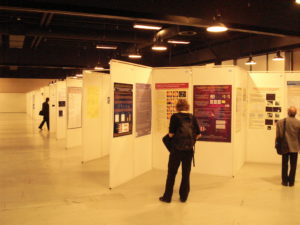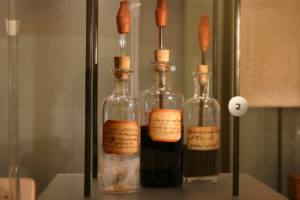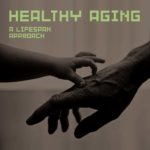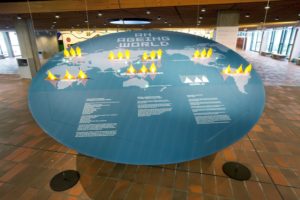Eye Catchers and Swagger Images: Research in Poster Format (2009) (Danish: Blikfang og blærebilleder – forskning i posterformat)
In contrast to most sci- and bio-art shows, Eye Catchers and Swagger Images highlighted the aesthetic practices within science itself. The guiding idea was that all medical scientific activity, in the laboratory and elsewhere, is permeated by aesthetic practices: there is no medical science action, site or space that is not, somehow, infused with aesthetic considerations, most probably unconscious. Scientific poster production is a lab practice which most scientists are acutely aesthetically aware about. The posters were collected in cooperation with medical researchers at the University of Copenhagen and most researchers were interviewed about their aesthetic considerations. Read more here.
Eye Catchers and Swagger Images opened at Medical Museion on 25 May 2009 and closed by the end of 2009.
Idea and production: Thomas Söderqvist; curator: Rikke Vindberg
Primary Substances: Treasures From the History of Protein Research (2009)
Primary Substances was about protein research in the long time perspective, from the early 19th century to the present, with a focus on analytical protein studies between the 1930s and 1980s, i.e., before the emergence of proteomics. The keyword was ’treasures’: Primary Substances displayed a rare collection of beautiful and historically important artefacts from the treasure chamber of 20th century analytical biomedicine, including the Carlsberg Laboratory, the Department of Biochemistry in Uppsala, and the Swedish pharmaceutical company Pharmacia. Read more here.
Primary Substances opened in the Exhibition Hall, Panum Building, University of Copenhagen on 4 September 2009 and closed by the end of 2009.
Idea/production/curator: Thomas Söderqvist; curator assistants: Jens Bukrinski, Adam Bencard, and Laura Maria Schütze; design: Mikael Thorsted; graphics: Lars Møller Nielsen; conservation work: Ion Meyer, Nanna Gerdes and Siri Wahlstrøm.
Healthy Aging: A Life Span Approach (2010)
The exhibition was quite basic. On big wall glass panels we presented, through texts and images, what scientists in the Center for Healthy Aging at the University of Copenhagen Faculty were doing. In the showcases we presented a collection of comissioned photo collages of 100 year-old Danish man and women made by photographer Liv Carlé Mortensen—a pretty unique work of art, which I captures the existential dimension of growing old. And in freestanding showcases displayed a series of historical technological artefacts that make old people overcome the deterioration of their bodily functions. Read my opening talk here.
Healthy Aging opened in the Exhibition Hall, Panum Building, University of Copenhagen on 8 February 2010, and closed by the end of 2010.
Production/curator: Thomas Söderqvist; co-curators: Bente Vinge Pedersen and Ion Meyer; curatorial assistants: Jonas Bejer Paludan, Camilla Undén, Nanna Gerdes and Jacob Kjærgaard; design: Mikael Thorsted; graphics: Lars Møller Nielsen.
An Ageing World (2010)
The inspiration for this art-science sculpture came from Otto Neurath’s notion of ‘pictorial statistics’. In An Ageing World, we placed physical age-pyramids on a large oval map of the world to illustrate the huge demographic differences between rich and poor countries. Over the months, thousands of medical faculty staff and students passed by the hanging sculpture, sometimes gathering in small groups around it to discuss global demography. Read more here.
An Ageing World opened on 5 October 2010, and ran until the end of 2011.
Idea: Thomas Söderqvist; production: Bente Vinge Pedersen and Thomas Söderqvist; design: Mikael Thorsted; graphics: Lars Møller Christensen.
The Chemistry of Life (2010)
Idea/production/curator: Thomas Söderqvist
Genomic Enlightenment (2011)
Idea/production/curator: Thomas Söderqvist
Femme Vitale (2013)
Curators: textile artist Susie Freeman and general practitioner Elizabeth Lee (Pharmacopeia).
Production: Thomas Söderqvist;
The Body Collected (2015)
Production: Bente Vinge Pedersen; labels (partly): Thomas Söderqvist

 Eye Catchers and Swagger Images
Eye Catchers and Swagger Images

